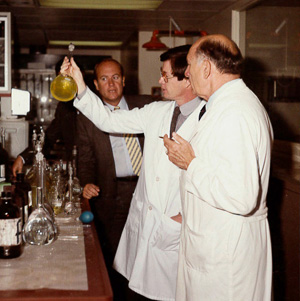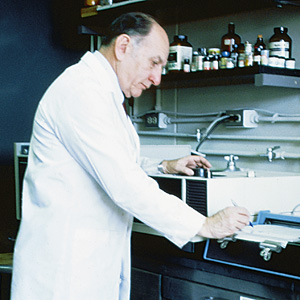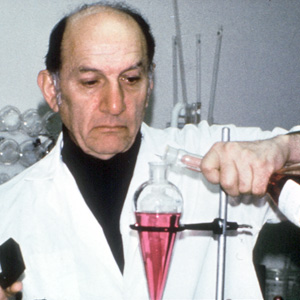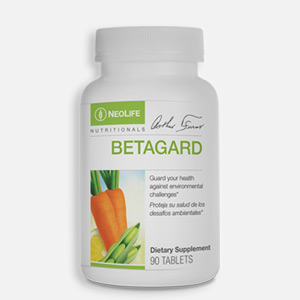ACHIEVEMENTS
Cancer Chemotherapy
- Cancer Chemotherapy
-

Cancer Research: Revolutionary Discovery #1 – Chemotherapeutic agents.
University of San Francisco: (1947-1951)
It was at USF that his interest in cancer, its causes and treatments began to form. Banding together a group of professors and students Dr. Furst literally built a small research lab devoted to the study of cancer, eventually making a revolutionary discovery of an injectable compound that actually killed cancer cells. Having proven this for the injectable form of the compound, he investigated if it would also work if added to food. That proved to be equally effective, generating the first ever evidence that oral cancer chemotherapy was possible. He shared his discovery with researchers at the University of California San Francisco (UCSF), then the only human cancer research and treatment center in the San Francisco area. As a joint effort with these UCSF medical doctors, Dr. Furst oversaw the treatment of human cancer patients with his compound, eventually publishing the first scientific paper on this new way to treat cancer patients in 1951….a method that would dominate the field of cancer research for decades.Stanford Medical: (1952-1961)
In 1952, Dr. Furst left his beloved USF to join the emerging cancer research program at the Stanford University Medical School, taking the position of Associate Professor of Pharmacology & Therapeutics (Medicinal Chemistry). The idea of using specific chemicals in medical treatment (literally medicinal chemistry) was beginning to draw a great deal of attention within the cancer research community and he quickly made his mark. By the middle of 1953, he was making presentations on the subject to the American Chemical Society. He received his first of many research grants from the American Cancer Society that same year.By 1954, Dr. Furst’s work on cancer chemotherapy was getting the attention of researchers throughout the United States. In March of that year, he was a keynote speaker at Stanford on the American Cancer Society’s “National Tour of Cancer Research Centers”. The findings of his research were circulated as key components of the “press releases” given to science writers in every major newspaper and scientific publication along the way.
Staying busy with long days and many nights in his lab, Dr. Furst’s work was showing that extracts from plants could be modified in ways so that they became cancer fighters. Developing more than 200 variants of these compounds, he found some that were very effective at killing off specific cancer cells.
For the next two years he continued to revolutionize the understanding of cancer causes and treatment. Becoming known as Stanford’s “authority on drug therapy for cancer”, in mid-1956 he was traveling the country presenting his discoveries before such prestigious groups as the Argonne National Laboratories Division of Biological and Medical Research, international conferences on Medicinal Chemistry and an invited lecturer at Harvard’s Children’s Cancer Research Foundation with world renown cancer specialist Dr. Sidney Farber. Arthur also received 3 more research grants that year and there was the creation of the Stanford Cancer Chemotherapy Laboratory.
In 1957, Dr. Furst was promoted to Full Professor of Medicinal Chemistry at Stanford, challenging him with the development and leadership of the Stanford Cancer Chemotherapy Laboratory. This was closely followed by yet another research grant to him from the US Public Health Service for his “Cancer Chemotherapy Program”.
1958 brought continued recognition and discovery for him. Once again he was a headliner on the American Cancer Society’s annual tour. This time he was highlighting a new discovery called Mineral Chelation. He summarized his work in this area by stating; “The unique ability of chelates to ‘claw’ metals out of combinations of chemicals may hold the secrets of both the cancer-causing and cancer-ameliorating properties of one and the same substance. The known cancer-producers and cancer drugs have turned out to be chelating agents.” This is a unique technology he would apply later in life as he worked to empower dietary nutrients to promote natural cancer prevention in the body.
Cancer Research: Revolutionary Discovery #2 – Chemotherapeutic cocktail.
1960 marks a pinnacle year in both Dr. Furst’s cancer research career as well as the way cancers would be treated forever after. Based on ongoing research in the Stanford Cancer Chemotherapy Laboratory, Dr. Furst and his team had concluded that though single chemotherapeutic agents worked quite well, some cancer cells could become resistant and allow the cancer to reappear in a stronger, more aggressive form a few months or years after treatment. It was from this work that he once again revolutionized cancer treatment science by creating and implementing the idea of multiple cancer chemotherapy agents used in concert. Creating a “cocktail” of specific chemotherapeutic agents to fight cancer overcame the problem of resistance. That discovery is still the state of the science for cancer treatment today, more than 5 decades later.
University of San Francisco (USF): Institute of Chemical Biology (1961-1980)
By 1961, following a decade of Cancer Chemotherapy discovery at Stanford Dr. Furst decides to return to his beloved USF, the genesis point of his initial chemotherapy concepts, and form the Institute for Chemical Biology. Soon after millions of dollars in research grants followed him.It was in this time that his research focus changed from finding ways to treat cancer to finding out how it started in the first place. From watching medical records closely for the previous decade, he had noticed that some industries had much higher cancer incidence than others. For example, men who worked in nickel refineries had a high incidence of nose and throat cancers. Once again, Dr. Furst changed the world of cancer research, showing that things within the environment can cause cancer…something taken for granted today, but revolutionary in the early 1960’s.
Dr. Furst’s work at USF got much recognition and resulted in factories and refineries across America, and around the world, having to rethink employee exposure risks and adjust the ways their businesses were run. Such changes have no doubt saved millions of people from cancer.
Dr. Furst’s work became so well known that in 1970 he was recognized by the World Health Organization (WHO) as the only American member of an international committee convened to fight cancer. Later that same decade he was called upon by the U. S. Secretary of Labor to help revise the Mine Safety Health Act, working to protect miners from the cancer causing realities of their jobs. In 1987, he was appointed by the U. S. Congress to be a consultant to the Environmental Protection Agency (USEPA), helping write the Clean Water Act. In 1994, the California State Senate designated his birthday, December 25th, as “Arthur Furst, Ph.D. Day”.
Toxicology
- Toxicology
-

Toxicology
Dr. Furst was well known for his pioneering work and outstanding contributions to the research and study of metals. From his work at the Stanford Chemotherapy Laboratory, it became apparent to him that some metals had powerful toxic properties that could cause cancer and other serious diseases. He spent a good deal of his time and effort over his years as a researcher that resulted in several imminent publications. Including; the first review that linked trace and toxic metals with cancer (1960); an entire book on chelation and cancer and predicting that platinum compounds should be made (1963), the first review on metal carcinogenesis (1969), the first attempt to understand the mechanism of metal carcinogenesis (1969); and a book (co-editor) on carcinogenic metals (1987).
Dr. Furst is the recipient of the Klaus Schwarz Medal (1986) in recognition of his role as a leading trace metals researcher as selected by the International Association of Bioorganic Scientists. He also received the Lifetime Contribution Award from the American College of Toxicology (first and only time ever given) and the Lifetime Recognition Award from the Society of Toxicology (first time ever awarded); both awards coming in 2004.
Earthworms & Metal Toxicity:
After decades of working with cancer-causing agents, Dr. Furst set out to find a non-animal model for determining the toxic potential of metals and chemical compounds. As part of his final contributions to cancer research in general and toxicology, in particular, he developed a protocol to evaluate toxicity using the common earthworm. Always the teacher, he worked closely with his students at USF on this important topic, even after his retirement and until just weeks before his passing in December of 2004.
The NeoLife Company: 1975-2005 – Nutrition and Disease Prevention
After nearly 2 decades as one of the world’s most important and prolific cancer researchers, Dr. Furst decided he wanted to switch gears a bit and begin focusing people on the idea that daily nutrition plays a critical role in disease prevention, in general, and cancer prevention, in particular. Finding the main-stream academic and scientific communities apparently incapable of grasping his ideas, he began to look elsewhere.
In 1975, he met with Mr. Donald Pickett, the founder of the NeoLife Company of America. Having been a proponent and promoter of the importance of nutrition to health since 1958, he found the NeoLife Company the perfect vehicle for delivering both his message about Nutrition and Health, as well as his ideas for how to assure maximum nutritional advantage through supplementation.
Mineral Chelation
- Mineral Chelation
-

Double Amino Acid technology:
As was his normal behavior everywhere he went, Dr. Furst immediately began making a positive impact on NeoLife products and the science that supports them. Because of his work with “Chelation” therapies for cancer treatment at Stanford in the 1960’s he also learned that chelation had the property of maximizing the absorption of nutritionally critical minerals. Through his work in and with the NeoLife laboratory, he developed a unique process of “Double Amino Acid Chelation” that enrobed normally hard to absorb minerals like calcium, magnesium, iron and zinc, in natural amino acids. This technique neutralized the highly reactive elemental forms of these minerals dramatically enhancing absorption potential. A “first-ever” protocol and technology still found only in NeoLife supplements to this day.
NeoLife Scientific Advisory Board: (1975-present)
Dr. Furst’s impact on NeoLife was so profound that the company committed to science in a way no other ever had. Because at this point in his career Dr. Furst was still an active and much sought after researcher, his academic schedule was still overflowing with work. At the same time though, he wanted to assure that his work at NeoLife got the attention he wanted it to have. To achieve this powerful balance between academics, science and the company, he proposed the creation of a scientific advisory board with and through whom he could share his knowledge and assure product and scientific excellence for the company. His proposal was accepted and the NeoLife Scientific Advisory Board, or SAB, as it affectionately known, was created. The initial team included Biochemist - Dr. Fred Hooper; Pathologist - Dr. Kenneth Hirsch and International Product Technologist - Mr. John Miller. The SAB remains at the helm of NeoLife product science and technology still today.
Detoxification
- Detoxification
-

Detoxification: ToxGard to BetaGard
Dr. Furst followed up on his powerful Double Amino Acid Chelation technology with the creation and introduction of ToxGard. Based on his years of research into cancer, its causes, and his deep understanding of toxicology Arthur created a formula that included a specific group of nutrients he knew played important roles in the body’s natural defensive detoxification processes. Shortly after, ToxGard was introduced (1982). He then produced an even more powerful version called BetaGard (1984). This version not only provided antioxidant and anti-toxin properties, but also the immune boosting power of natural, whole food carotenoids. This original research opened the door to additional whole food carotenoid scientific investigation and product development that set NeoLife apart from every other nutritional supplement company in the world.